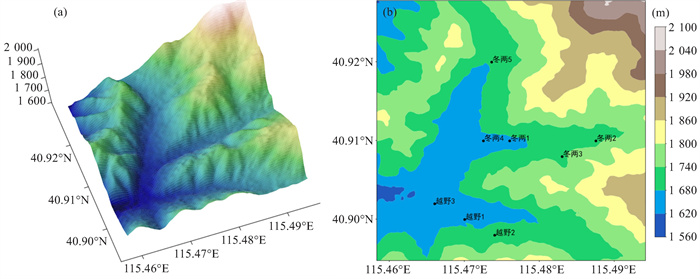Analysis of Valley Wind Circulation Characteristics in the Guyangshu Winter Olympics Competition Area Under Complex Terrain
-
摘要: 利用2017—2020年冬奥赛场加密自动站资料和ERA5再分析资料,通过风矢量平均法和合成分析法,从特殊地形和大气环流背景角度出发,对古杨树赛区风场环流演变特征进行研究。结果表明,古杨树赛区受地形阻挡及热力作用明显,场馆内风向风速具有明显的地形风特征差异。白天时段内风向相对分散,风速主要在5 m·s-1以下,夜间段内风向普遍集中且风速较小,主要分布在3 m·s-1以下;同场馆内以下坡风为主导的站点比以下谷风为主导的站点风速更小,主要在2 m·s-1以下。弱冷空气背景下,白天转向时间在08时前后,傍晚在17—19时前后,转换期时长平均在1.5~2.0 h,转换时间先后及转换期时长明显受太阳辐射影响;风速随着风向的转变先减小后增大,冬季两项赛区在09时前后达到一天内最小日平均风速,12—14时达到一天中最大日平均风速,而越野赛区一天中最大日平均风速出现在12—15时;各站点的日平均风速与其所在位置的地形风尺度有关,受谷风影响的站点风速往往大于受坡风影响的站点风速。Abstract: This study investigates the dynamics and characteristics of air flow in the Guyangshu competition area by analyzing intensive observation of automatic weather stations and ERA5 reanalysis data collected in the Winter Olympics field from 2017 to 2020. Considering its distinct topography and the context of atmospheric circulation, wind vector averaging and composite analysis methods are employed to improve analyses. Results indicate that the Guyangshu competition area is highly influenced by terrain and thermal effects, resulting in significant differences in terrain wind characteristics. Daytime wind directions are relatively scattered, with speeds mostly below 4-5 m · s-1. At night, wind directions are more concentrated, and speeds are generally below 2-3 m · s-1. Within the same competition venue, stations dominated by down-slope winds have lower wind speeds, mainly below 1-2 m · s-1, compared to those dominated by down-valley winds. Under weak cold air conditions, wind direction shifts typically occur around 08:00 in the morning and between 17:00-19:00 in the evening. The transition period averages 1.5- 2 hours, with the timing and duration of these changes are significantly influenced by solar radiation. As the wind direction changes, wind speeds first decrease and then increase. In the winter competition areas, the lowest average daily wind speeds are observed around 09:00, while peak average daytime wind speeds are observed between 12: 00 and 14: 00. In off-road competition zones, the highest daily average wind speeds are recorded between 12:00 and 15:00. The average daily wind speeds at each station correlate with the terrain's wind scale in their locations, with stations influenced by valley winds often have higher speeds than those affected by slope winds.
-
Key words:
- Winter Olympics /
- valley wind /
- slope wind /
- complex terrain /
- cold air
-
表 1 自动气象观测站信息
序号 站名 经度/°′″E 纬度/°′″N 海拔/m 1 冬两1号站 1152829 405435 1 650.2 2 冬两2号站 1152915 405437 1 724.0 3 冬两3号站 1152859 405428 1 698.0 4 冬两4号站 1152821 405440 1 670.3 5 冬两5号站 1152825 405512 1 671.6 6 越野1号站 1152818 405403 1 640.5 7 越野2号站 1152826 405353 1 687.5 8 越野3号站 1152757 405406 1 622.8 -
[1] EGGER J. Thermally forced flows: Theory. In Atmospheric Processes over Complex Terrain[M]. Boston MA: American Meteorological Society, 1990: 43-58. [2] WHITEMAN C D. Mountain Meteorology: Fundamentals and Applications[M]. New York: Oxford University Press, 2000: 171. [3] ROTACH M W, CALANCA P, GRAZIANI G, et al. Turbulence structure and exchange processes in an alpine valley: The Riviera project[J]. Bull Amer Meteor Soc, 2004, 85(9): 1 367-1 385. [4] SERAFIFIN S, ADLER B, CUXART J, et al. Exchange processes in the atmospheric boundary layer over mountainous terrain[J]. Atmosphere, 2018, 9: 102. [5] 李国平. 近25年来中国山地气象研究进展[J]. 气象科技进展, 2016, 6(3): 115-122. [6] EKHART E. De la structure thermique de l'atmosphere dans lamontagne (On the thermal structure of the mountain atmosphere)[J]. La Meteor, 1948, 4(9): 3-26. [7] ZARDI D, WHITEMAN C D. Diurnal mountain wind systems[M]//Mountain Weather Research and Forecasting. Dordrecht: Springer, 2013: 35-119. [8] ISAKSSON R. Numerical simulation of diurnal planetary boundary layer effects and diurnal mountain-wind effects[D]. Sweden: Uppsala University, 2016: 1-35. [9] VERGEINER I, DREISEITL E. Valley wind and slope winds-Observation and elementary thoughts[J]. Meteor Atmos Phy, 1987, 36(1-4): 264-286. [10] WHITEMAN C D. Observations of thermally developed wind systems in mountainous terrain[M]//BLLIMEN W. Atmospheric Processesover Complex Terrain. Boston: American Meteorological Society, 1990: 5-42. [11] DEFANT F. Zur Theorie derhangwinde, nebst bemerkungen zur theorie der Berg-und Talwinde(A theory of slope winds, along with remarks on the theory of mountain winds and valley winds)[J]. Arch Meteor Geophys Bioklimatol, Ser. A, 1949, 1: 421-450. [12] EKHART E. Beitrege zur Alpinen meteorologie (Contributions to Alpine meteorology)[J]. Meteor Z, 1944, 61(7): 217-231. [13] 田越, 苗峻峰. 中国地区山谷风研究进展[J]. 气象科技, 2019, 47(1): 41-51. [14] 傅抱璞. 山谷风[J]. 气象科学, 1980, 1(1/2): 1-14. [15] 季国良, 王尧奇, 沈志宝, 等. 兰州市区冬季的低空环流[J]. 高原气象, 1984, 3(2): 4-50. [16] 覃军, 袁业畅, 李燕, 等. 山区复杂地形条件下的风场分析[J]. 气候与环境研究, 2001, 6(4): 493-497. [17] 王玉玺. 兰州盆地的小气候特征[J]. 兰州大学学报(自然科学版), 1983, 19(3): 118-129. [18] 霍文, 杨青, 艾力·买买提明, 等. 天山北坡四工河流域6月山谷风特征分析[J]. 新疆气象, 2005, 28(6): 17-19. [19] 吕新生, 王旭, 蔡仁, 等. 乌鲁木齐辖区山谷风环流特征的分析[J]. 干旱区地理, 2016, 39(6): 1 172-1 180. [20] 董群, 赵普生, 王迎春, 等. 北京山谷风环流特征分析及其对PM2. 5浓度的影响[J]. 环境科学, 2017, 38(6): 2 218-2 230. [21] 高登义. 珠穆朗玛峰绒布河谷的冰川风[J]. 冰川冻土, 1985, 7(3): 249-256. [22] 孙方林, 马耀明. 珠穆朗玛峰北坡地区河谷局地环流特征观测分析[J]. 高原气象, 2007, 26(6): 1 187-1 190. [23] 王瑾, 张镭, 王腾蛟, 等. 兰州附近山谷典型日环流特征对比分析[J]. 干旱气象, 2012, 30(2): 169-177. [24] 周荣卫, 何晓凤. 新疆哈密复杂地形风场的数值模拟及特征分析[J]. 高原气象, 2018, 37(5): 1 413-1 427. [25] 张嘉荣, 程雪玲. 基于CFD降尺度的复杂地形风场数值模拟研究[J]. 高原气象, 2020, 39(1): 172-184. [26] 刘蓓. 祁连山南麓夏季地形云特征及山谷风影响分析[J]. 气象科技, 2016, 44(1): 67-75. [27] 张人文, 范绍佳, 李颖敏. 2008年秋季从化山谷风观测研究[J]. 热带气象学报, 2012, 28(1): 134-139. [28] ZHONG S, WHITEMAN C D, BIAN X. Diurnal evolution of three-dimensional wind and temperature structure in California's Central Valley[J]. J Appl Meteor, 2004, 43(11): 1 679-1 699. [29] 吕明华, 闫江雨, 姚仁太, 等. 风向的统计方法研究[J]. 气象与环境学报, 2012, 28(3): 83-89. -






 下载:
下载:











 粤公网安备 4401069904700003号
粤公网安备 4401069904700003号